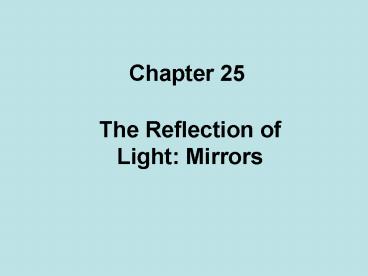The Reflection of Light: Mirrors - PowerPoint PPT Presentation
1 / 14
Title:
The Reflection of Light: Mirrors
Description:
mirror perpendicularly and reflects back on itself. The Formation of Images by Concave Mirrors ... Ray Tracing for a Convex Mirror. Ray 1. This ray is initially ... – PowerPoint PPT presentation
Number of Views:2148
Avg rating:3.0/5.0
Title: The Reflection of Light: Mirrors
1
Chapter 25
- The Reflection of Light Mirrors
2
Wave Fronts and Rays
3
The Reflection of Light
Law of Reflection The incident ray,
the reflected ray, and the noral to the surface
all lie in the same plane, and the angle of
reflection is equal to the angle incidence
4
The Formation of Images by a Plane Mirror
5
Formation of Images by a Plane Mirror
6
Full-Length Versus Half-Length Mirrors
7
Spherical Mirrors
8
Spherical Mirrors
Concave Mirror
Convex Mirror
9
The Formation of Images by Spherical Mirrors
Ray Tracing for a Concave Mirror Ray 1. This ray
is initially parallel to the principal axis and,
therefore, passes through the focal point F
after reflection from the mirror Ray 2. This
ray passes through the focal point F and is
reflected parallel to the principal axis. Ray
3. This ray travels along a line that passes
through the center of curvature C and follows a
radius of the spherical mirror as a result,
the ray strikes the mirror perpendicularly and
reflects back on itself
10
The Formation of Images by Concave Mirrors
11
The Formation of Images by Convex Mirrors
Ray Tracing for a Convex Mirror Ray 1. This ray
is initially parallel to the principal axis and,
therefore, appears to originate from the focal
point F after reflection from the mirror Ray
2. This ray heads toward the focal point F
emerging parallel to the principal axis after
reflection. Ray 3. This ray travels toward the
center of curvature C as a result, the ray
strikes the mirror perpendicularly
and reflects back on itself
12
The Mirror Equation and the Magnification Equation
The Mirror Equation
The Magnification Equation
13
Sign Conventions for Spherical Mirrors
Focal Length
f is ___ for a concave mirror. f is ___ for a
convex mirror.
Object Distance
d0 is ___ if the object is in front of a mirror
(real object). d0 is ___ if the object is behind
the mirror (virtual object).
Image Distance
di is ___ if the object is in front of a mirror
(real object). di is ___ if the object is behind
the mirror (virtual object).
Magnification
m is ___ for an image that is upright with
respect to the object. m is ___ for an object
that is inverted with respect to the object.
14
Example 1
An object is placed 9.00 cm in front of a mirror.
The image is 3.00 cm closer to the mirror when
the mirror is convex than when it is planar.
Find the focal length of the convex mirror (p.
776)
Example 2
The radius of curvature of a mirror is 12 cm. A
diamond ring is placed in front of this mirror.
The image is twice the size of the ring. Find
the object distance of the ring. (p. 776)































